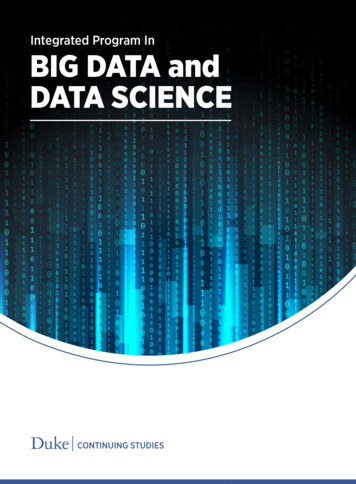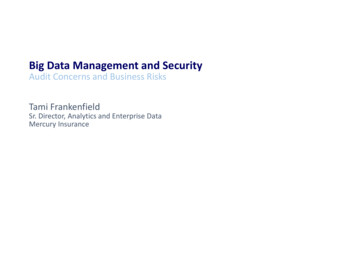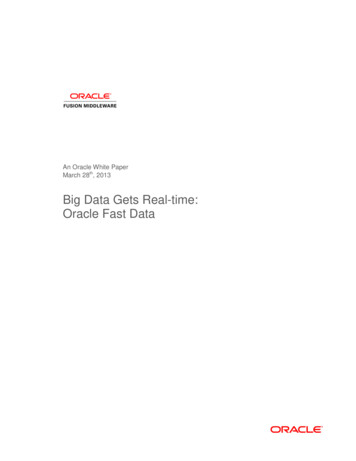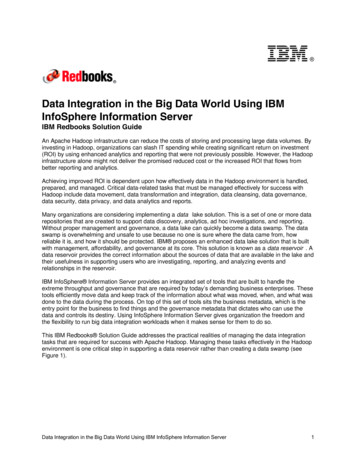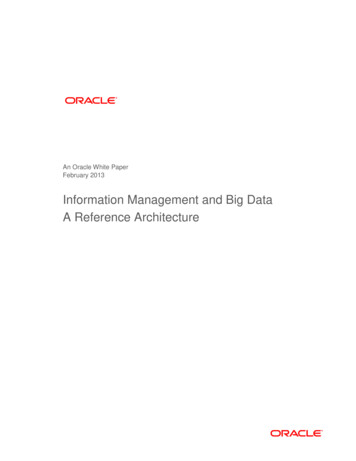
Transcription
An Oracle White PaperFebruary 2013Information Management and Big DataA Reference Architecture
Information Management and Big Data, A Reference ArchitectureDisclaimerThe following is intended to outline our general product direction. It is intended for information purposesonly, and may not be incorporated into any contract. It is not a commitment to deliver any material, code, orfunctionality, and should not be relied upon in making purchasing decisions. The development, release, andtiming of any features or functionality described for Oracle’s products remains at the sole discretion ofOracle.
Information Management and Big Data, A Reference ArchitectureIntroduction . 1Background . 3Information Management Landscape. 3Extending the Boundaries of Information Management . 4Big Data Opportunity in Customer Experience Management . 5Information Management Reference Architecture Basics . 9Knowledge Discovery Layer and the Data Scientist . 10Knowledge Discovery Layer and Right to Left Development . 12What is Big Data? . 14Big Data Technologies. 16Big Data and the IM Reference Architecture . 18Knowledge Stripping – Find the ROI Approach . 18Knowledge Pooling – Assume the ROI Approach . 21Choosing the Right Approach . 23Big Data needs Big Execution and Agile IM . 24Cautious First Steps . 25Conclusions . 27Finding out more about Oracle’s IM Reference Architecture . 28
Information Management and Big Data, A Reference ArchitectureIntroductionIn the original Oracle white paper on Information Management Reference Architecture wedescribed how “information” was at the heart of every successful, profitable and transparentbusiness in the world – something that’s as true today as it was then. Information is thelifeblood of every organization and yet Information Management (IM) systems are too oftenviewed as a barrier to progress in the business rather than an enabler of it. At best IM is anunsung hero.What has changed in the last few years is the emergence of “Big Data”, both as a means ofmanaging the vast volumes of unstructured and semi-structured data stored but not exploitedin many organizations, as well as the potential to tap into new sources of insight such associal-media web sites to gain a market edge.It stands to reason that within the commercial sector Big Data has been adopted more rapidlyin data driven industries, such as financial services and telecommunications. Theseorganizations have experienced a more rapid growth in data volumes compared to othermarket sectors, in addition to tighter regulatory requirements and falling profitability.Many organizations may have initially seen Big Data technologies as a means to ‘managedown’ the cost of large scale data management or reduce the costs of complying with newregulatory requirements. This has changed as more forward-looking companies haveunderstand the value creation potential when combined with their broader InformationManagement architecture for decision making, and applications architecture for execution.There is a pressing need for organizations to align analytical and execution capabilities with‘Big Data’ in order to fully benefit from the additional insight that can be gained.Received wisdom suggests that more than 80% of current IT budgets is consumed justkeeping the lights on rather than enabling business to innovate or differentiate themselves inthe market. Economic realities are squeezing budgets still further, making IT’s ability to change1
Information Management and Big Data, A Reference Architecturethis spending mix an even more difficult task. For organizations looking to add some elementof Big Data to their IT portfolio, they will need to do so in a way that complements existingsolutions and does not add to the cost burden in years to come. An architectural approach isclearly what is required.In this white paper we explore Big Data within the context of Oracle’s Information ManagementReference Architecture. We discuss some of the background behind Big Data and review howthe Reference Architecture can help to integrate structured, semi-structured and unstructuredinformation into a single logical information resource that can be exploited for commercial gain.2
Information Management and Big Data, A Reference ArchitectureBackgroundIn this section, we will review some Information Management background and look at the newdemands that are increasingly being placed on Data Warehouse and Business Intelligence solutions bybusinesses across all industry sectors as they look to exploit new data sources (such as social media) forcommercial advantage. We begin by looking through a Business Architecture lens to give somecontext to subsequent sections of this white paper.Information Management LandscapeThere are many definitions of Information Management. For thepurposes of this white paper we will use a broad definition thathighlights the full lifecycle of the data, has a focus on the creationof value from the data and somewhat inevitably includes aspects ofpeople, process and technology within it.While existing IM solutions have focused efforts on the data that isreadily structured and thereby easily analysed using standard(commodity) tools, our definition is deliberately more inclusive. Inthe past the scope of data was typically mediated by technical andcommercial limitations, as the cost and complexities of dealingwith other forms of data often outweighed any benefit accrued.With the advent of new technologies such as Hadoop and NoSQLas well as advances in technologies such as Oracle Exadata, manyof these limitations have been removed, or at the very least, thebarriers have been expanded to include a wider range of data typesand volumes.What we mean by InformationManagement:Information Management (IM) isthe means by which anorganisation seeks to maximisethe efficiency with which itplans, collects, organises, uses,controls, stores, disseminates,and disposes of its Information,and through which it ensuresthat the value of that informationis identified and exploited to themaximum extent possible.As an example, one of our telecommunications customers hasrecently demonstrated how they can now load more than 65 billion call data records per day into anexisting 300 billion row relational table using an Oracle database. While this test was focused verysquarely at achieving maximum throughput, the key point is that dealing with millions or even billionsof rows of data is now much more common place, and if organised into the appropriate framework,tangible business value can be delivered from previously unimaginable quantities of data. That is theraison d’être for Oracle’s IM Reference Architecture.Although newer hardware and software technologies are changing what is possible to deliver from anIM perspective, in our experience the overall architecture and organising principles are more critical. Afailure to organise data effectively results in significantly higher overall costs and the growth of a‘shadow IT’ function within the business i.e. something that fills the gap between IT deliverycapabilities and business needs. In fact, as part of a current state analysis we often try to measure thesize of the ‘shadow IT’ function in our customers as a way of quantifying IM issues. How manypeople and how much time is spent preparing data rather than analysing it? How has the ‘Shadow-IT’function influenced tools choices and the way in which IM is delivered? ‘Shadow IT’ can impose asignificant additional burden in costs, time and tools when developing a transitional roadmap.3
Information Management and Big Data, A Reference ArchitectureIn many instances, we find existing IM solutions have failed to keep pace with growing data volumesand new analysis requirements. From an IT perspective this results in significant cost and effort intactical database tuning and data reorganization just to keep up with ever changing business processes.Increasing data volumes also put pressure on batch windows. This is often cited by IT teams as themost critical issue, leading to additional costly physical data structures being built such as OperationalData Stores and Data Caches so a more real-time view of data can be presented. These structuresreally just serve to add cost and complexity to IM delivery. The real way to tackle the batch loadwindow is not to have one.Data in an IM solution tends to have a natural flow rate determined either by some technologicalfeature or by business cycles (e.g. Network mediation in a mobile network may generate a file every 10minutes or 10,000 rows, whichever is sooner, where as a business may re-forecast sales every 3months).By trickle feeding data at this underlying flow rate into the staging data layer, batch issues can beeliminated and the IM estate rationalised. We argue that by adopting Oracle’s IM ReferenceArchitecture you will be able to support rapid collaborative development, incorporating new data andnew analysis areas, and thus keep pace with business change while dramatically reducing the size of‘shadow-IT’ in your organization.Extending the Boundaries of Information ManagementThere is currently considerable hype in the press regarding Big Data. Articles often feature companiesconcerned directly with social media in some fashion, making it very difficult to generalise about howyour organization may benefit from leveraging similar tools, technology or data. Many of these socialmedia companies are also very new, so questions about how to align Big Data technologies to theaccumulated complexity of an existing IM estate are rarely addressed.Big Data is no different from any other aspect of Information Management when it comes to addingvalue to a business. There are two key aspects to consider: How the new data or analysis scope can enhance your existing set of capabilities? What additional opportunities for intervention or processes optimisation does it present?Figure 1 shows a simplified functional model for the kind of ‘analyse, test, learn and optimise’ processthat is so key to leveraging value from data. The steps show how data is first brought together beforebeing analysed and new propositions of some sort are developed and tested in the data. Thesepropositions are then delivered through the appropriate mechanism and the outcome measured toensure the consequence is a positive one.4
Information Management and Big Data, A Reference ArchitectureFigure 1. Simple functional model for data analysisThe model also shows how the operational scope is bounded by the three key dimensions of Strategy,Technology and Culture. To maximise potential, these three dimensions should be in balance. There islittle point in defining a business strategy that cannot be supported by your organizations IT capacityor your employees ability to deliver IT.Big Data Opportunity in Customer Experience ManagementA common use-case for Big Data revolves around multi-channel Customer Experience Management(CX). By analysing the data flowing from social media sources we might understand customersentiment and adapt service delivery across our channels accordingly to offer the best possiblecustomer experience.If we animate our simplified functional model (Figure 1) in a CX context we see the first task is tobring the data together from disparate sources in order to align it for analysis. We would normally dothis in a Data Warehouse using the usual range of ETL tools. Next, we analyse the data to look for5
Information Management and Big Data, A Reference Architecturemeaningful patterns that can be exploited through new customer propositions such as a promotion orspecial offer. Depending on the complexity of the data, this task may be performed by a BusinessAnalyst using a BI toolset or a Data Scientist with a broader range of tools, perhaps both. Havingdefined a new proposition, appropriate customer interventions can be designed and then executedthrough channels (inbound/outbound) using OLTP applications. Finally, we monitor progress againsttargets with BI, using dashboards, reports and exception management tools.Many modern ‘next best offer’ recommendations engines will automate each of the steps shown in ourfunctional model and are integrated into OLTP applications that are responsible for the final offerdelivery.It’s also interesting to note how the functional model shown in figure 1 maps against the differenttypes of analysis and BI consumers shown in figure 2. In many organizations it falls to the BusinessAnalyst to perform the required ‘Data Analysis and Proposition Development’ function using astandard BI toolset, rather than a Data Scientist using a more specialised suite of tools applied in amore agile fashion. It seems reasonable to suggest that the latter will be more successful in unlockingthe full potential value of the data.Another important point to make regarding this mapping is the need for the ‘Monitoring, Feedbackand Control’ feedback loop which must link back at the Executive level through EnterprisePerformance Management (EPM) to ensure that strategy is informed and adjusted based onoperational realities.Figure 2. Information consumers and types of analysis6
Information Management and Big Data, A Reference ArchitectureTo be successful in leveraging Big Data, organizations must do more than simply incorporate newsources of data if they are to capture its full potential. They must also look to extend the scope of theirCRM Strategy and organizational culture as well as fit newer Big Data capabilities into their broader IMarchitecture. This point is shown conceptually in Figure 3 below. For example, telecoms companieswho may have previously run a set number of fixed campaigns against defined target segments maynow be able to interact with customers on a real-time basis using the customer’s location as a trigger.But how should promotions be designed in order to be affordable and effective in this new world?How can we avoid fatiguing customers through the increased number of interventions?What new reports must be created to track progress? How can these new opportunities for interactionand the data coming back from channels be used in other areas of customer management such asBrand Management, Price Management, Product and Offering Design, Acquisition and RetentionManagement, Complaint Management, Opportunity Management and Loyalty Management? Theseare all important questions that need to be answered, preferably before the customer has moved to acompetitor or ticked the ‘do not contact’ box because they’re fed up with being plagued by marketingoffers.Figure 3. Conceptual expansion of functional model to include Big Data7
Information Management and Big Data, A Reference ArchitectureIt’s also worth noting from Figure 1 that the data analysis and proposition development is separatedfrom the proposition delivery (i.e. channel execution). While that seems self evident when representedin this fashion, we find that many people conflate the two functions when talking about technologiessuch as Data Mining. We will discuss this point again when looking at the role of Data Scientists, butwe can see how the development of a Data Mining model for a problem such as target marketing isseparate from the scoring of data to create a new list of prospects. These separate activities map wellto the proposition analysis and proposition delivery tasks shown in our diagram Figure 1.We would note that CX is just one example of a domain where Big Data and Information Management(more generally) can add value to an organization. You can see from our original definition that IM isall about data exploitation and applies equally to every other business domain.8
Information Management and Big Data, A Reference ArchitectureInformation Management Reference Architecture BasicsOracle’s Information Management Reference Architecture describes the organising principles thatenable organizations to deliver an agile information platform that balances the demands of rigorousdata management and information access. See the end of this white paper for references and furtherreading.The main components of Oracle’s IM Reference Architecture are shown in Figure 4 below.Figure 4. Main components of the IM Reference ArchitectureIt’s a classically abstracted architecture with the purpose of each layer clearly defined. In brief these are: Staging Data Layer. Abstracts the rate at which data is received onto the platform from the rate atwhich it is prepared and then made available to the general community. It facilitates a ‘right-time’flow of information through the system. Foundation Data Layer. Abstracts the atomic data from the business process. For relationaltechnologies the data is represented in close to third normal form and in a business process neutralfashion to make it resilient to change over time. For non-relational data this layer contains theoriginal pool of invariant data. Access and Performance Layer. Facilitates access and navigation of the data, allowing for the currentbusiness view to be represented in the data. For relational technologies data may be logical orphysically structured in simple relational, longitudinal, dimensional or OLAP forms. For nonrelational data this layer contains one or more pools of data, optimised for a specific analytical task9
Information Management and Big Data, A Reference Architectureor the output from an analytical process. e.g., In Hadoop it may contain the data resulting from aseries of Map-Reduce jobs which will be consumed by a further analysis process. Knowledge Discovery Layer. Facilitates the addition of new reporting areas through agiledevelopment approaches and data exploration (strongly and weakly typed data) through advancedanalysis and Data Science tools (e.g. Data Mining). BI Abstraction & Query Federation. Abstracts the logical business definition from the location ofthe data, presenting the logical view of the data to the consumers of BI. This abstraction facilitatesRapid Application Development (RAD), migration to the target architecture and the provision of asingle reporting layer from multiple federated sources.One of the key advantages often cited for the Big Data approach is the flexibility of the data model (orlack thereof) over and above a more traditional approach where the relational data model is seen to bebrittle in the face of rapidly changing business requirements. By storing data in a business processneutral fashion and incorporating an Access and Performance Layer and Knowledge Discovery Layerinto the design to quickly adapt to new requirements we avoid the issue. A well designed DataWarehouse should not require the data model to be changed to keep in step with the business andprovides for rich, broad and deep analysis.Over the years we have found that the role of sandboxes has taken on additional significance. In this(slight) revision of the model we have placed greater emphasis on sandboxes by placing into a specificKnowledge Discovery Layer where they have a role in iterative (BI related) development approaches,new knowledge discovery (e.g. Data Mining), and Big Data related discovery. These three areas aredescribed in more detail in the following sections.Know
Big Data Opportunity in Customer Experience Management A common use-case for Big Data revolves around multi-channel Customer Experience Management (CX). By analysing the data flowing from social media sources we might understand customer sentiment and adapt service delivery across our channels accordingly to offer the best possibleFile Size: 1MB






